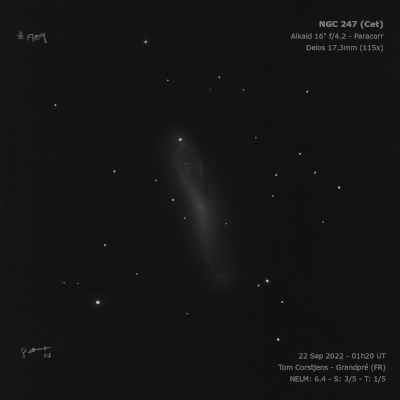
William Herschel discovered NGC 247 = H V-20 = h57 on 20 Oct 1784 (sweep 303) and logged "a Streak of light about 27' long, and in the brightest part, which was pB is 3' or 4' broad. The extension nearly in the meridian (I believe a little from from S.p. to N.f.) ... The situation is so low, that it would probably appear of much greater extent in a higher altitude." John Herschel observed NGC 247 at Slough on 16 Sep 1830 (sweep 293) and noted "eF; vL; vmE; vglbM; 10' long; pos 172.0 deg. Has no bright star in it, but a star 8.9 mag at some distance n.p." Surprisingly, he made no (published) observations at the Cape of Good Hope.
Based on a photograph taken with the Crossley reflector, Heber Curtis described NGC 247 as "a faint, very large spiral, 18'x5' in p.a. 175°. Nucleus stellar; many almost stellar condensations. Whorls somewhat irregular, and indistinct." (1918)
200/250mm - 8" (10/4/80): very large, elongated ~N-S, bright core. A mag 10 star is at the south tip. The southern extension appears brighter.
300/350mm - 13" (8/5/83): fairly bright, diffuse, very large, bright core.
400/500mm - 17.5" (11/1/86): bright, very large, bright core, elongated 7:2 N-S, 14'x4'. The southern extension is brighter and mag 9 SAO 166572 is superimposed at the southern end about 6' from the core. Burbidge's Chain (VV 518) lies 18' NNE.
900/1200mm - 48" (10/31/13): at 287x, NGC 247 spanned at least 18'x5' NNW-SSE and stretched from an HII region at the NNW tip to beyond a mag 9.5 star (HD 4529) near the SSE end. A very large, elongated darker region (though not primarily caused by dust extinction), dubbed the "Needle's Eye", forms an interesting feature on the NNW side of the halo. Visually it extended at least 3.5'x1.0'. A relatively bright HII knot (identified in NED as MRSS 540-038059 from the "Muenster Red Sky Survey") is beyond this feature at the NNW end of the major axis, 9.5' from center. This knot appeared fairly faint, relatively large for an HII region, elongated ~N-S, 20"x12". A second well-defined HII knot is MRSS 540-038506, found 5' NNW of center. This easy patch appeared fairly faint, elongated, 15"x10". At least two small knots (including MRSS 540-038001) are on the SW side of the halo, ~2.4' from center and ~1.5' E of a mag 12-12.5 star just off the west edge of the disc. Finally, I picked up a faint, very small knot, ~6" diameter, situated 3.5' SSE of center and 1.1' N of a mag 13.5 star. This HII region (not in the MRSS) forms a "double" with a mag 15 star 15" N.
Notes by Steve Gottlieb